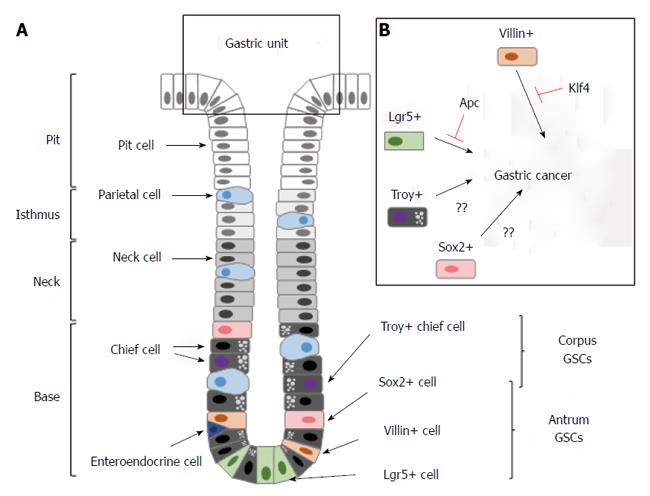Copyright
©The Author(s) 2015.
World J Gastroenterol. Jan 7, 2015; 21(1): 112-123
Published online Jan 7, 2015. doi: 10.3748/wjg.v21.i1.112
Published online Jan 7, 2015. doi: 10.3748/wjg.v21.i1.112
Figure 1 Hypotheses that explain the cellular heterogeneity, initiation and progression of cancer.
A: In the clonal evolution hypothesis, cellular heterogeneity is generated by genetic instability, such as changes in chromosomal number or mutations in the genome of the tumor cells. Those cells with genetic compositions that confer growth advantages will be selected and preferentially expanded; B: In the cancer stem cell (CSC) hypothesis, CSCs reside at the top of the cellular hierarchy and govern tumor heterogeneity. CSCs divide to generate identical CSCs (self-renewal) and differentiate into phenotypically heterogeneous, but usually less proliferative, tumor cells. It is believed that CSCs are often transformed tissue-specific stem cells or de-differentiated transit amplifying progenitor cells.
Figure 2 Stem cells that reside in gastric units.
A: An illustration of a gastric unit and the presence of several populations of gastric stem cells (GSCs), all of which can replenish the entire cellular population of the gastric units. In the antrum, Villin+ and Lgr5+ GSCs represent the quiescent and actively dividing stem cells, respectively. Villin+ GSCs are located in the lower third, while Lgr5+ GSCs are often found at the base of the gastric unit. In the corpus, populations of Troy+ chief cells that reside in the base are multipotent GSCs. Sox2+ GSCs are present in both the antrum and the corpus; B: The transformation of GSCs that reside in the stomach can lead to gastric cancer. The inactivation of Klf4 in Villin+ GSCs or of Apc in Lgr5+ GSCs can lead to gastric cancer in the antrum in mouse models. It is remains unclear whether the transformation of Troy+ or Sox2+ GSCs can cause gastric cancer in the corpus. GSCs: Gastric stem pcells.
- Citation: Zhao Y, Feng F, Zhou YN. Stem cells in gastric cancer. World J Gastroenterol 2015; 21(1): 112-123
- URL: https://www.wjgnet.com/1007-9327/full/v21/i1/112.htm
- DOI: https://dx.doi.org/10.3748/wjg.v21.i1.112










